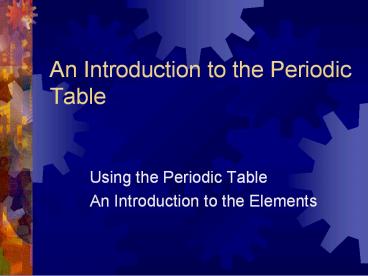An Introduction to the Periodic Table - PowerPoint PPT Presentation
1 / 12
Title:
An Introduction to the Periodic Table
Description:
An Introduction to the Periodic Table Using the Periodic Table An Introduction to the Elements Periodic Table Why Periodic???? The properties of the elements repeat ... – PowerPoint PPT presentation
Number of Views:1106
Avg rating:3.0/5.0
Title: An Introduction to the Periodic Table
1
An Introduction to the Periodic Table
- Using the Periodic Table
- An Introduction to the Elements
2
Periodic Table
- Why Periodic????
- The properties of the elements repeat in in a
periodic way. - Invaluable tool for chemistry
- Used for organization
- History of the table
- Newlands
- Meyer
- Mendeleev
- Mosley
3
The Modern Periodic Table
- Elements are arranged by atomic number
- Typical box contains
- Name of the element
- Symbol
- Atomic number
- Atomic mass
4
Periods Horizontal Rows
- Numbered 1-7
5
Groups Vertical Columns
- Numbered 1-18
6
Interactive Periodic Tables
- http//periodic.lanl.gov/index.shtml
- www.webelements.com
- www.chemicool.com
- http//education.jlab.org/itselemental/ele016.html
7
Classification of the Elements
- Metals
- Nonmetals
- Metalloids
8
Metals
- Occupy the left side of the periodic table
- Have luster, shiny
- Solids at room temp except Hg
- Ductile ability to be drawn into wires
- Malleable ability to be hammered into sheets
- Excellent conductors of heat and electricity
- Tend to form positive ions
9
NonMetals
- Occupy the right side of the Periodic Table
- Generally gases or brittle solids
- Dull-looking
- Brittle
- Poor conductors of heat and electricity
- Bromine is the only liquid at room temp
- Tend to form negative ions
10
Metalloids
- Characteristics of
- metals and nonmetals
11
Classification of the Elements
- Families of elements share the same ending
electron configuration - therefore they share similar chemical
characteristics - Valence Electrons electrons in the highest
principal energy level - Determine Chemical reactivity
- Elements in a group share the same number of
valence electrons
12
Families of elements (Groups)
- Share structural and chemical (behavioral)
characteristics - Alkali Metals
- Alkaline Earth Metals
- Transition Elements
- Halogens
- Nobel Gases































